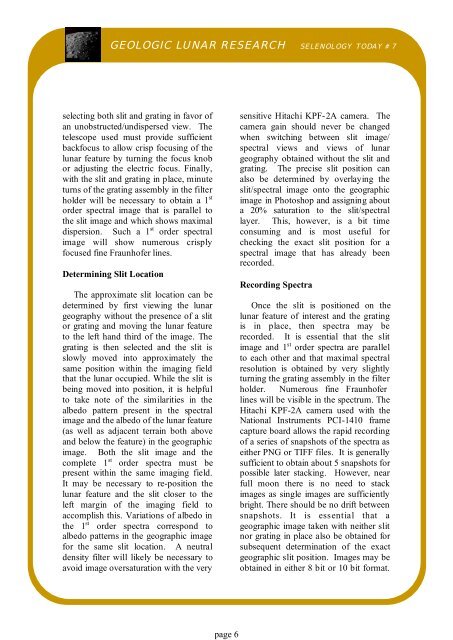Selenology Today # 7 July 2007 - Home
Selenology Today # 7 July 2007 - Home
Selenology Today # 7 July 2007 - Home
Create successful ePaper yourself
Turn your PDF publications into a flip-book with our unique Google optimized e-Paper software.
GEOLOGIC LUNAR RESEARCH SELENOLOGY TODAY # 7<br />
selecting both slit and grating in favor of<br />
an unobstructed/undispersed view. The<br />
telescope used must provide sufficient<br />
backfocus to allow crisp focusing of the<br />
lunar feature by turning the focus knob<br />
or adjusting the electric focus. Finally,<br />
with the slit and grating in place, minute<br />
turns of the grating assembly in the filter<br />
holder will be necessary to obtain a 1 st<br />
order spectral image that is parallel to<br />
the slit image and which shows maximal<br />
dispersion. Such a 1 st order spectral<br />
image will show numerous crisply<br />
focused fine Fraunhofer lines.<br />
Determining Slit Location<br />
The approximate slit location can be<br />
determined by first viewing the lunar<br />
geography without the presence of a slit<br />
or grating and moving the lunar feature<br />
to the left hand third of the image. The<br />
grating is then selected and the slit is<br />
slowly moved into approximately the<br />
same position within the imaging field<br />
that the lunar occupied. While the slit is<br />
being moved into position, it is helpful<br />
to take note of the similarities in the<br />
albedo pattern present in the spectral<br />
image and the albedo of the lunar feature<br />
(as well as adjacent terrain both above<br />
and below the feature) in the geographic<br />
image. Both the slit image and the<br />
complete 1 st order spectra must be<br />
present within the same imaging field.<br />
It may be necessary to re-position the<br />
lunar feature and the slit closer to the<br />
left margin of the imaging field to<br />
accomplish this. Variations of albedo in<br />
the 1 st order spectra correspond to<br />
albedo patterns in the geographic image<br />
for the same slit location. A neutral<br />
density filter will likely be necessary to<br />
avoid image oversaturation with the very<br />
page 6<br />
sensitive Hitachi KPF-2A camera. The<br />
camera gain should never be changed<br />
when switching between slit image/<br />
spectral views and views of lunar<br />
geography obtained without the slit and<br />
grating. The precise slit position can<br />
also be determined by overlaying the<br />
slit/spectral image onto the geographic<br />
image in Photoshop and assigning about<br />
a 20% saturation to the slit/spectral<br />
layer. This, however, is a bit time<br />
consuming and is most useful for<br />
checking the exact slit position for a<br />
spectral image that has already been<br />
recorded.<br />
Recording Spectra<br />
Once the slit is positioned on the<br />
lunar feature of interest and the grating<br />
is in place, then spectra may be<br />
recorded. It is essential that the slit<br />
image and 1 st order spectra are parallel<br />
to each other and that maximal spectral<br />
resolution is obtained by very slightly<br />
turning the grating assembly in the filter<br />
holder. Numerous fine Fraunhofer<br />
lines will be visible in the spectrum. The<br />
Hitachi KPF-2A camera used with the<br />
National Instruments PCI-1410 frame<br />
capture board allows the rapid recording<br />
of a series of snapshots of the spectra as<br />
either PNG or TIFF files. It is generally<br />
sufficient to obtain about 5 snapshots for<br />
possible later stacking. However, near<br />
full moon there is no need to stack<br />
images as single images are sufficiently<br />
bright. There should be no drift between<br />
snapshots. It is essential that a<br />
geographic image taken with neither slit<br />
nor grating in place also be obtained for<br />
subsequent determination of the exact<br />
geographic slit position. Images may be<br />
obtained in either 8 bit or 10 bit format.


